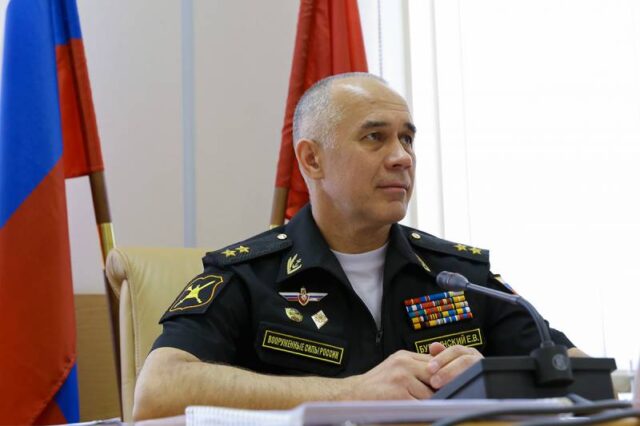
Moscow Re-Organizes Russian Armed Forces (Part Two)
Publication: Eurasia Daily Monitor Volume: 20 Issue: 170
By:

The series of unsuccessful offensives in the Kupyansk and Avdiivka directions have caused major problems for Russian forces in Ukraine (Ukrinform, October 27; Kyiv Independent, October 29). The Russian army is losing military equipment at a high rate, which Moscow seemingly considers a worse problem than heavy manpower losses along the front (see EDM, October 31). The rate of domestic production for critical arms and munitions is well below the rate necessary to adequately replenish growing deficits. Military plants supply the so-called “mobilized” versions of tanks, which are repaired practically from scratch. The growing supply of equipment with rare modifications or experimental equipment from the late 1980s and early 1990s reveal the truly dire state of affairs in the Russian army (T.me/Tanki-Istoriya-i-sovremenost’, October 23). Such concerns are what originally motivated the Kremlin to announce the mass re-organization of the Russian Armed Forces (see Part One).
The pace of these reforms picked up greatly this past summer. On June 2, Deputy Chief of the Russian General Staff Colonel-General Evgeny Burdinsky reported, “In 2023, it is necessary to timely carry out … the formation of the combined arms and air forces, the army corps, the Azov Naval District, five divisions, and 26 brigades” (Gazeta.ru, June 2). As a result, Russia’s military districts began carrying out more concerted efforts to re-organize its existing forces and create new formations. Most recently, on November 1, the Kremlin announced plans to integrate 25,000 specialists trained in the use of hi-tech weaponry into the existing Russian brigades as well as newly formed units (TASS, November 1).
In general, the reorganization of the Russian military can be summarized with the following units being created in each military district (see EDM, June 6).
In the Western Military District:
- The 3rd Army Corps headquarters was formed at the end of 2022 (ru, December 21, 2022).
- The management of the 3rd Army Corps in Karelia is currently being formed.
- The 6th Motor Rifle Division and the 17th High-Power Artillery Brigade were also formed (name, September 4).
In the Southern Military District:
- The 1st Army Corps of the so-called “Donetsk People’s Republic” and 2nd Army Corps of so-called “Luhansk People’s Republic” were created and subordinated to the 8th Combined Arms Army (TASS, February 19).
- The 1st Army Corps includes the 1st, 5th, 9th, 110th, 114th, and 132nd motor rifle brigades, 14th Artillery Brigade, and several separate regiments and battalions.
- The 2nd Army Corps includes the 4th, 7th, 85th, 88th, and 123rd motor rifle brigades, the 10th Artillery Brigade, and several separate regiments and battalions.
- The command of the 18th Army Corps was formed on the basis of the command of the 22nd Army Corps (see Part One).
- The command of the 40th Army Corps was merged with the command of the 144th Motor Rifle Brigade.
- The 47th and 70th motor rifle divisions were formed and the 52nd Artillery Brigade was created as part of the airborne troops stationed in the Southern Military District.
In the Central Military District:
- The command of the 25th Combined Arms Army Reserve was formed (Defence-ua.com, September 21).
- The 67th Motor Rifle Division and the 72nd Motor Rifle Brigade were created.
- Formation of the 104th Guards Airborne Division is underway on the basis of the 31st Air Assault Brigade.
In the Eastern Military District:
- The formation of the 55th Naval Infantry Division in the Pacific Fleet was announced (TASS, April 3).
These reforms represent a significant overhaul in the organization of the Russian Armed Forces. The newly formed units constitute:
- Two new combined arms armies with newly formed commands;
- Two new army corps, merging commands with those of other units;
- Three new motor rifle divisions;
- One new motor rifle brigade and four re-organized motor rifle brigades;
- Three new motor rifle regiments;
- Two high-power artillery brigades;
- One new air assault division.
The Kremlin’s re-organization efforts also extended to the Russian National Guard (Rosgvardia). This summer, 116 separate special-purpose brigades were added, whose prime area of operation will be the Russian-occupied territories in Ukraine (Temryuckiy Raion, September 6). In general, the practice of creating new regional battalions within the National Guard has been expanded. For example, the process is already underway to form the Bashkir battalion “Salavat Yulaev” as part of these new units (Asilikul, August 14).
The deployment of these units and the re-formation of the Moscow and Leningrad military districts suggest that Russia expects to use these units as cadres. Given the overall need for more contract soldiers, these units will likely be reinforced with freshly mobilized and conscripted recruits. On average, 10,000 to 15,000 are reportedly being mobilized every month in Russia to replenish combat units and form new ones. The planned units will presumably be deployed during the next wave of large-scale mobilization, which Moscow continues to avoid. Mass resignations at state-owned enterprises and the growth in newly created units of mobilized personnel point to the growing possibility that the Kremlin will be forced to launch the next phase of mobilization in the near future and risk enflaming societal tensions with Russia (Author’s interview, October 20).



